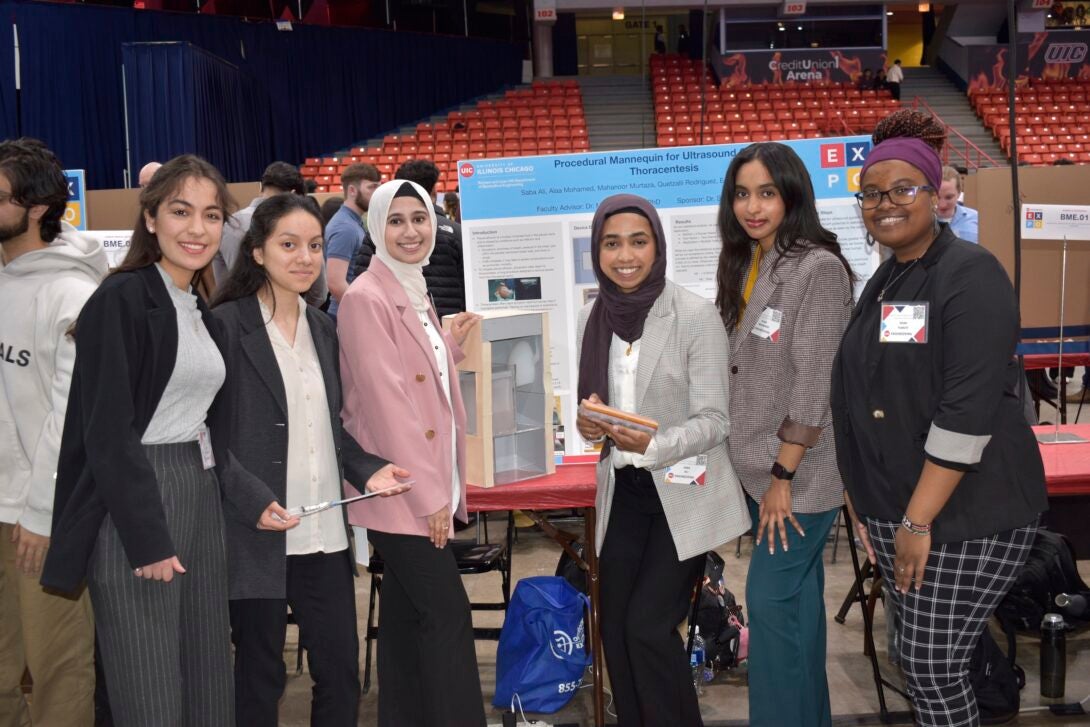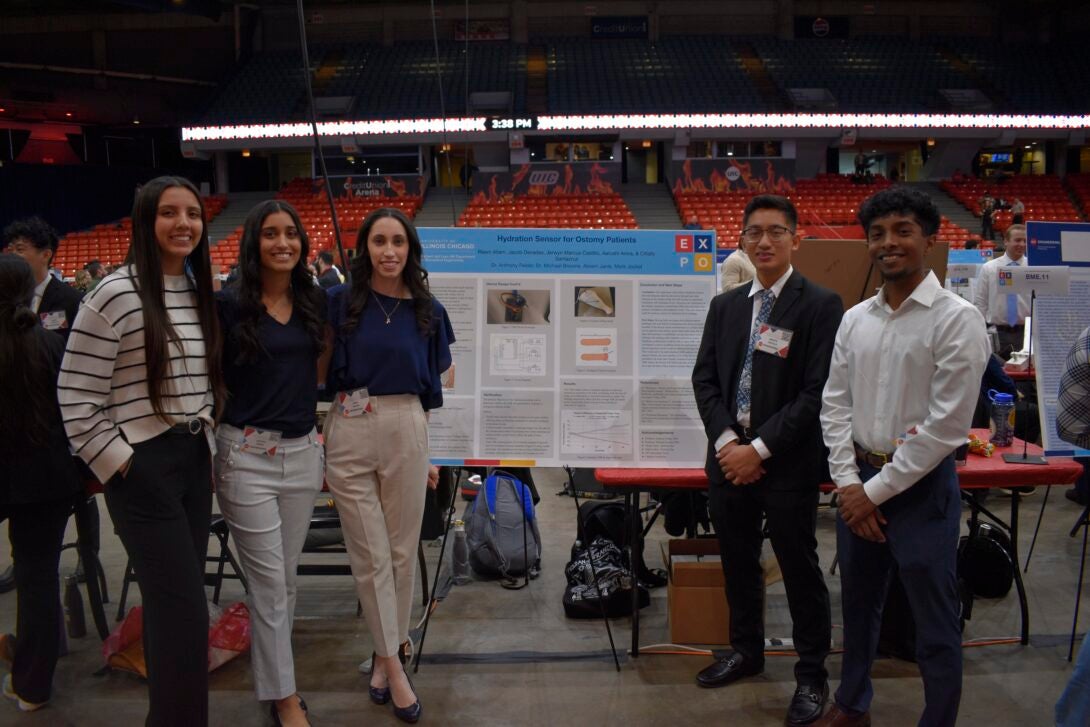BME students showcase skills at annual expo
block Heading link
Richard and Loan Hill Department of Biomedical Engineering students displayed creativity during the annual UIC Engineering Design Expo at the Credit Union 1 Arena on April 19.
The expo featured teams from across the College of Engineering who were challenged to solve real-world engineering problems as part of a required senior design course. More than 150 judges, including Chicago-area engineering professionals, alumni, and former COE faculty, participated in the event.
The student teams created a wide variety of projects, including an inclusive electroencephalogram, a thoracentesis procedural mannequin, a device to ease prostate biopsy patient discomfort, and much more. Learn about all the projects at Engineering Expo 2024.
Procedural Mannequin for Ultrasound Guided Thoracentesis Heading link

Nearly 180,000 thoracentesis procedures are conducted annually in the U.S. alone.
As a common and low-risk procedure, thoracentesis is done to drain extra fluid from around the lungs, or the pleural space, to treat pleural effusion and is used to test for infections and other illnesses.
Pleural effusion is the excess of fluid in the pleural space. Thoracentesis is done by puncturing the pleural cavity and then draining the fluid with a catheter. Ultrasound is used prior to the puncture to ensure that the needle placement is done correctly.
Seniors Alaa Mohamed, Mahanoor Murtaza, Quetzalli Rodriguez, Edah Tumuti, Leslie Villanueva, and Saba Ali created an ultrasound-guided thoracentesis training simulator.
They designed a mannequin to provide medical students and new physician residents with a tool to practice and familiarize themselves with the thoracentesis procedure.
“Using this preliminary training, medical personnel could exhibit fewer procedural errors when practicing on actual patients,” Mohamed said. “With more procedural proficiency, patients would have a faster recovery time and reduced risk of post-procedural complications.”
They aimed to maintain low manufacturing costs, ensure a complete procedure for medical students, and be a sustainable training method. This project was heavily based on manufacturing and physical molding, which was a new experience for this group– working heavily with computer-aided design, 3D printing, and silicone molding.
While working on their project, the seniors enjoyed applying their classroom knowledge and skills in biomedical engineering to address a real-world problem. More specifically, they found that developing a tangible product that is highly accessible and cost-effective and has the potential to make a positive impact in medical education has been incredibly rewarding.
Hydration Sensor for Ostomy Patients Heading link

Ileostomies, an opening created in the abdominal wall to allow a small portion of the ileum or small intestine to be brought to the skin’s surface to allow stool to pass directly out of the body, are commonly used for various gastrointestinal diseases. However, these anatomic and physiologic alterations often render ileostomy patients vulnerable to complications, including dehydration. Approximately 40% of post-ileostomy re-admissions are due to dehydration.
A continued partnership between seniors in the department and Hollister Incorporated, a medical device company focusing on ostomy and continence care, is working to improve the lives of patients using ostomy pouches.
BME seniors Reem Allam, Citlally Santacruz, Aarushi Arora, Jacob Devadas, and Jerwyn Castillo worked to create a sensor to monitor hydration status in ostomy patients. This sensor utilizes impedance measurements using galvanic skin response of the stoma area to potentially offer a more reliable and accessible method for older individuals with limited mobility.
Their research focused on developing a low-maintenance and user-friendly device to accurately measure the impedance and hydration levels of the patient using fresh chicken skin and intestine as surrogate models.
“Our study identified the stoma site as a promising location for sensor placement, offering a unique interface for monitoring hydration levels in ostomy patients,” Arora said. “By providing a non-invasive and reliable method for assessing hydration status, our approach has the potential to significantly improve patient outcomes and quality of life and reduce the risk of rehospitalization.”
The group hopes to eventually make the device more user-friendly by adjusting its size to be usable with an ostomy pouch according to its user.
Addressing Patient Discomfort During Prostate Biopsy Heading link

A transrectal ultrasound scan (TRUS) is an examination of the prostate gland using ultrasound to help potentially diagnose prostate cancer. This procedure is a five- to 15-minute outpatient procedure that uses sound waves to create a video image of the prostate gland.
Urologists and supporting nurses struggle with keeping patients still during this procedure due to the lack of equipment specialized in stabilizing, mobility limitations, and patient discomfort. According to the National Institutes of Health, a long operative time during the TRUS procedure and strong pre-procedure anxiety can increase pain for patients undergoing the procedure without anesthesia and cause patients to be unwilling to undergo TRUS again without anesthesia.
BME seniors Philip George, Abed Daloul, Marti Castillo, Carina Huerta, Tyler Bastin, and Michelle Alemu designed a device to reduce positioning discomfort for the patient, be reusable and durable, and assist in improving the accuracy of the procedure.
There are currently very few solutions for a TRUS prostate biopsy procedure, such as bean bag positioners and pregnancy pillows, which do not take the left lateral decubitus (LLD) position into account during the conditions of a prostate biopsy. The LLD position is a fundamental patient orientation employed in medical imaging where the patient lies on the left side with the body’s longitudinal axis perpendicular to the imaging table.
To reduce patient discomfort, a device with a mattress base, back support, and thigh support is used. The entire device is transportable and can be secured atop the typical procedure chair.
“The thigh support carriage utilizes pegs that can be moved to best fit specific patient measurements and height along a rail that grants the device adjustability and inclusivity,” Huerta said. “It works to maintain a hip angle that is more acute than 95 degrees for different sized patients. The device verification protocol required subjects to utilize the device in LLD positioning to mirror the TRUS procedure, placing markers to be captured and processed through MATLAB for angle calculations, and performing a left-sided T-test to have a 95% confidence level that subjects’ hip angles reach below 95 degrees.”
The seniors found that their device keeps subjects in the LLD position but isn’t yet up to medical standards, meaning that the resulting device is insufficient for medical-grade use in the procedure room because of the wooden base.
“Our device will be used to help reduce patient discomfort during a TRUS prostate biopsy,” Daloul said. “The device’s patient impact will decrease overall discomfort during prostate biopsy and increase validity of prostate cancer detection. Further, this device is one of the first LLD body positioners for TRUS procedures; this innovation can open the doors to creating more surgical stabilizers for other specific positions with patient comfort in mind.”